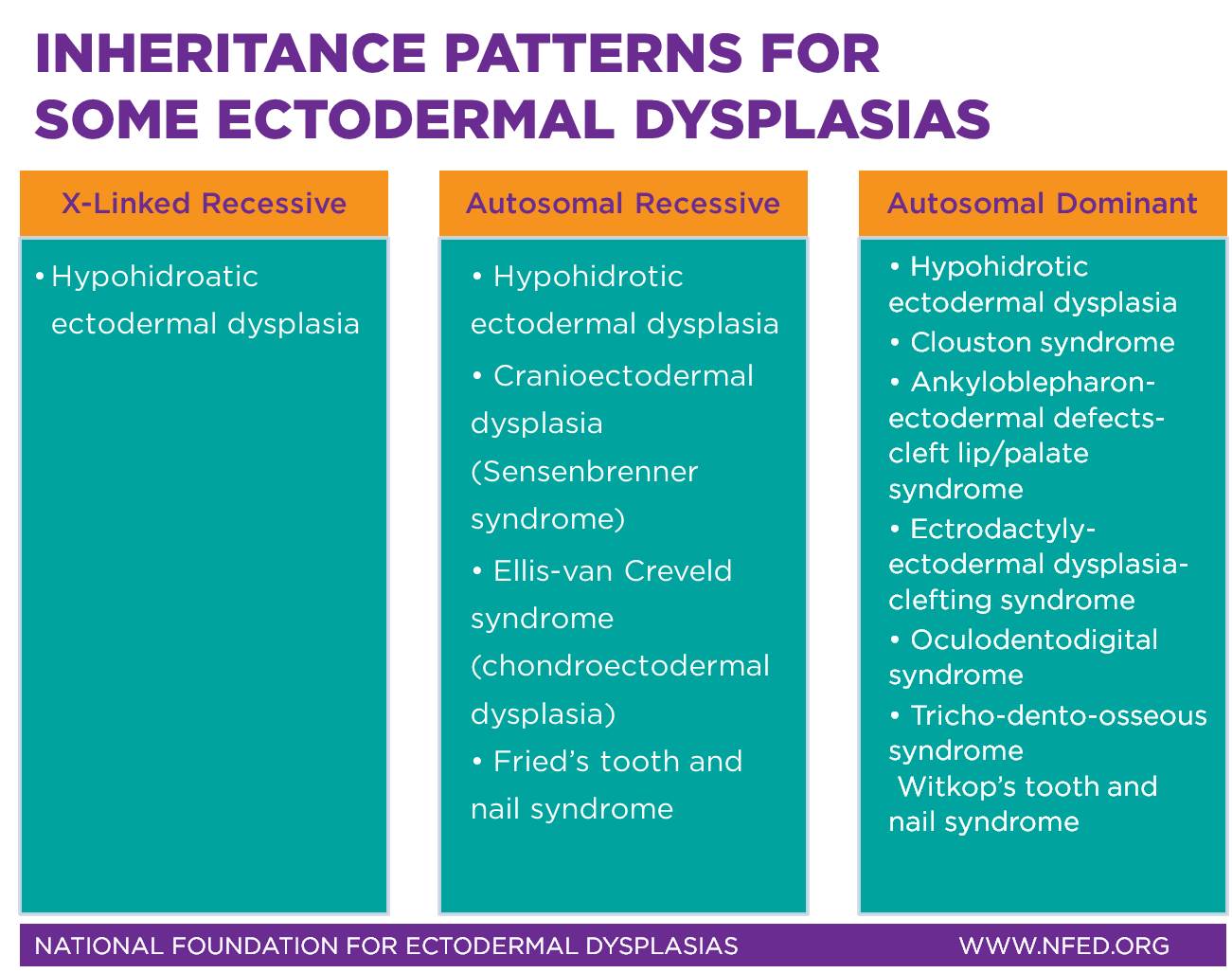The pattern of inheritance for an ectodermal dysplasia is crucial to understand whether or not there is a risk for relatives of an affected individual to be affected. It becomes an important component in the description of each type of ectodermal dysplasia. The patterns and their associated risks are listed below.
- The inheritance pattern of an autosomal dominant disorder is as follows.
- Males and females may be affected.
- Affected males and affected females may transmit the disorder to their children.
- Each child, born to an affected person has a 50% chance to be affected.
- The inheritance pattern of an autosomal recessive disorder is as follows.
- Males and females may be affected.
- The parents of affected children usually do not appear to be affected, although they probably are carriers of the mutation.
- Each child, regardless of gender, born to carrier parents has a 25% chance to be affected.
- The inheritance pattern of an X-linked (recessive) disorder is as follows.
- Males only are fully affected, although females who are carriers may show mild signs of the disorder.
- All daughters of affected males are carriers.
- None of the sons of affected males is affected.
- Each child born to a carrier female has a 50% chance to inherit the gene; sons who do inherit it will be affected, daughters who do will be carriers.

Special Considerations about Inheritance
The most important thing for you to remember is that there are exceptions to all rules. The inheritance pattern in your family may not match those listed above because of some unexpected event or unlikely combination of genes.
Or, it may be that your family is not large enough for the “rules” to be obvious. The best example of the impact of small family size on inheritance pattern relates to gender determination.
Most people know that is as likely (50% chance) that a pregnancy will result in the birth of a boy as a girl. Yet, a given couple may have three, four or even five sons, but no daughters. The chance that the next child will be boy is still only 50%; the rules don’t change depending on a relatively small number of outcomes.
Similarly, having one or more children affected by an ectodermal dysplasia does not change the inheritance pattern. Each pregnancy faces the risk predicted by the inheritance pattern for the ectodermal dysplasia in the family.
One Family, One Disorder
It is equally important to remember that genetic disorders, including the ectodermal dysplasias, “breed true” in families. If there is an abnormal gene (a mutation) in a family, it will cause the same disorder in whomever inherits the gene. There may be modest variation in the way the mutation expresses itself (relatively mild or relatively severe), but the same altered gene suddenly will not cause a different type of ectodermal dysplasia or another genetic disorder.
The predictable way that the mutations for the ectodermal dysplasias show up in different people should give some comfort to families of affected individuals. For the most part, they know what they’re dealing with from the very start, since the physical features of the ectodermal dysplasia are easily seen and relatively well documented in the medical literature or in NFED articles.
This article is adapted from The Multi-Syndrome Guide to the Ectodermal Dysplasias published by the NFED.
Read other educational articles about ectodermal dysplasias:
14 Things You Didn’t Know About Ectodermal Dysplasias
Food Allergies and Ectodermal Dysplasia
Top 10* Most Common Ectodermal Dysplasias
Share Your Story
[…] It’s All in the Genes […]
[…] It’s All in the Genes […]